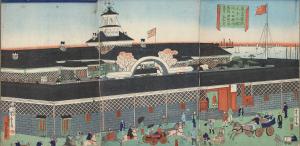Tokyo Tsukiji Hotel Building (Tokyo Tsukiji Hoteru-kan)
1870 (Meiji 3) Tokyo Shiryō Collection 728-C3
Tsukiji Hotel is the first western-style hotel in Japan built as a foreign residence in Tsukiji. The appearance of this hotel became highly praised as a new famous spot of Tokyo that would usher in a new modernity, and many sightseers came to visit. Artists also competed to capture the hotel in nishiki-e (colored woodblock prints).
The artist Utagawa Yoshitora (1828-1888) was famed as a painter from the end of the Tokugawa Shogunate until the middle of the Meiji period. His greatest works were the drawings known as Yokohama-e (pictures of Yokohama) and kaika-e (enlightenment pictures), which captured the new customs before and after the Meiji Restoration, and this work is a part of the kaika-e.
The official name for the Tsukiji Hotel is the Edo Hotel and in this painting the upper section of the western-style architecture can be seen over the outer surroundings. There is a script saying "with a frontage of 40-ken, depth of 42-ken, height of 9-jō 3-shaku" and from this we can grasp the scale of the main building.
nfortunately this Tsukiji Hotel building burned down only four years after completion and was accordingly called the "Hotel of Illusion" but its name is left in history as the building that represents the dawn of a new era from the closing of the Tokugawa Shogunate to the opening of the Meiji period. The place where the Tsukiji Hotel stood is now where the multi-story car park of the central wholesale market is.


